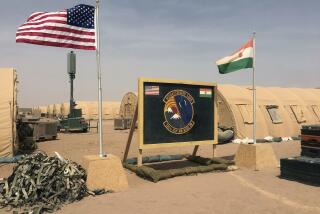U.S. to Return Okinawa Base to Japanese
- Share via
TOKYO — Japan and the United States announced plans Friday to return a major military air base on the southern island of Okinawa to local landowners, easing the most troubling issue in the two countries’ security ties before President Clinton arrives here next week.
Japanese Prime Minister Ryutaro Hashimoto and U.S. Ambassador Walter F. Mondale said the Futenma Marine Corps Air Station, a key strategic facility for the Marines, will be returned within seven years and its functions transferred to two other bases in Japan.
Futenma became the national symbol of the U.S. military’s unpopular presence on the island--an issue made even worse after the rape last year of an Okinawan schoolgirl. The crime, involving three U.S. servicemen, sparked Okinawa’s biggest anti-American protests in three decades.
Critics have warned that any accident at the base, which is near a school in the heavily populated town of Ginowan, could ignite a violent reaction that would drive U.S. forces off Okinawa, still their most important military launching pad in Asia.
Mondale said the two countries redoubled their efforts to resolve the issue after an appeal by Hashimoto during his meeting with Clinton in Santa Monica in February.
Defense Secretary William J. Perry is scheduled to announce here Monday the rest of the Okinawa measures, which Japanese media reports say will involve the largest transfer of land back to Japanese owners since the island reverted to Japanese control in 1972. The United States had controlled the island in accordance with a 1951 treaty.
When Clinton and Hashimoto meet here Wednesday, they are expected to announce plans to strengthen the security alliance as the foundation for continued peace and prosperity in Asia.
“In Okinawa, Americans live as neighbors, and we want to be good neighbors,” Mondale said after a 90-minute meeting with Hashimoto at the prime minister’s residence.
He said Futenma’s return will significantly reduce “the irritants and the intrusiveness of the American presence in Okinawa” without compromising U.S. capabilities or readiness.
Okinawa hosts nearly half of the 47,000 U.S. troops in Japan, and officials said the overall number that will not be appreciably reduced by Futenma’s return.
Futenma is home to 4,000 U.S. personnel as well as about 80 helicopters, 14 KC-130 tanker aircraft and three administrative aircraft. It also has Okinawa’s second-longest runway, able to accommodate major combat aircraft.
Under the agreement announced Friday, a new heliport would be constructed on another base in Okinawa, but Air Force Lt. Gen. Richard B. Myers, commander of U.S. forces in Japan, said the search for a suitable site is “just slightly past the starting line.”
Japan agreed to pay for most of the construction and relocation.
In addition, the tanker aircraft, used in airborne refueling, would move to Iwakuni Air Base on the Japanese main island of Honshu and that Harrier jump jets based there would return to the United States. The two countries also agreed to study the possibility of using Japanese runways during emergencies to replace those at Futenma.
Futenma itself would be converted into an international agricultural center, according to Japanese reports.
Hashimoto called the agreement only the first step in easing the burden on Okinawans, who complain that they have long endured crime, noise and pollution from the bases.
“I feel quite relieved that, by making our best efforts, we were able to come up with an answer to take away one of the burdens that Okinawa has been carrying for such a long time,” Hashimoto said.
Ginowan Mayor Seiken Tobaru said the accord will bring relief from deafening noise, risk of accidents and stunted economic development.
“The accord made me feel like jumping with joy,” he said.
But some Okinawans were skeptical, saying the plan merely shifts the problem to other areas. Okinawa Gov. Masahide Ota, whose refusal to renew leases for U.S. military facilities helped focus top-level government attention on the issue, expressed muted appreciation for the plan.
Ota praised Hashimoto’s “strong decisiveness” in persisting in requests to return the airfield. But local residents expressed mixed feelings.
“We’ve been betrayed by such pledges for a long time,” said one demonstrator at an anti-base rally of 10,000 people Friday in Okinawa.
The prefecture is calling for the return of all major bases by 2015. Last year, Japan and the U.S. agreed to return two other major facilities, the Naha Military Port and Yomitan Auxiliary Airfield, once new training areas are established.
But Tokujitsu Miyagi, the mayor of the Okinawan city of Kadena, where some of the Marine training facilities would be moved, said the town could not endure more flights.
“We were never asked by the government to accept the bases,” Miyagi said. “We were forced to accept it, so the unbearable pain will only increase.”
Chiaki Kitada of The Times Tokyo Bureau contributed to this report.
More to Read
Sign up for Essential California
The most important California stories and recommendations in your inbox every morning.
You may occasionally receive promotional content from the Los Angeles Times.














